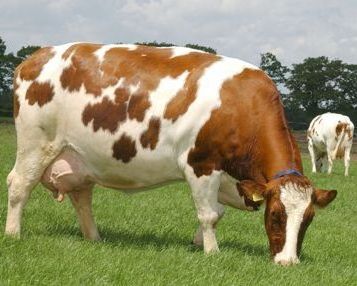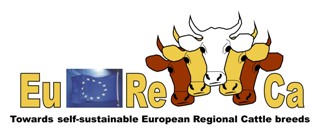Meuse-Rhine-Yssel cattle (MRY)
 Photo: Veeteelt |
|
Breed description
Dual purpose, sober, strong, calm, robust, muscled red and white cattle. Thick thighs and strong legs. Females are about 135-140 cm in height and weigh 600-800 kg. Males somewhat taller. Strong points of the MRY breed are longevity, low veterinary cost, little feet or fertility problems and high revenues from sale of cull stock, resulting in a high net income or margin per kg of milk. The optimal environment for the MRY breed is considered to be a production system with much grass or silage, or even with permanent pasture, a so called extensive farm management system (<12.000 kg milk/ha).History: origin of the breed and main region or country
MRY was developed in two regions in the Netherlands, in the province Overijssel and in the eastern part of Brabant. MRY is a dual purpose breed, selected for both milk and meat production. Since 1874 animals are registered in the Nederlands Rundvee Syndicaat (NRS) an since 1905 MRY is recognized as a breed. There are also populations of MRY or (strong) related breeds in Luxembourg, Belgium (Belgian Red Pied or Pie Rouge de Belgique), Germany (German Red or Deutsche Rotbunte), Spain and also in Ireland and Eastern Europe.Trend of population
In the period 1960-1970 around 25% of the cattle population in the Netherlands was MRY. The trend in the 1970s towards use of more specialized for milk and meat breeds, especially the introduction of the Red Holstein, resulted in a dramatic decrease in the number of purebred MRY.| Year | Number of adult females of MRY (pedigree >87.5% MRY) |
|---|---|
| 1975 | > 500.000 |
| 1999 | 31.036 |
| 2002 | 18.339 |
| 2004 | 14.124 |
Together with the decrease in the number of breeding females, intensive use of only a limited number of MRY breeding males narrowed the genetic diversity in the MRY breed. In 1995, for example, 26% of all purebred MRY offspring was sired by one male. In 2001, the eradication of Foot and Mouth Disease negatively affected the MRY breeding population size further. In 2003, there were only 12 farms left in the Netherlands with 100% purebred MRY. Calculated on the basis of 85-100% MRY, there were still 103 herds.
Breeding, conservation and promotion
At the moment the MRY breed generates more positive publicity. The number of inseminations by MRY bulls is increasing, especially for crossbreeding purposes. Two regional societies of MRY breeders (MRY-East and MRY-South) promote the use of MRY, in particular the positive characteristics and efficiency in low-input farming. A large percentage of the MRY breeders is not associated with any of the two.The regional societies MRY-East and MRY-South are also involved in the breeding program for MRY, advising the breeding organization CRV on selection of MRY bulls and promoting a sufficient number of new young MRY to be tested each year. Semen from 176 MRY bulls, collected between the 1960s and 2005, is conserved in the gene bank and managed by the Centre for Genetic Resources, the Netherlands.


